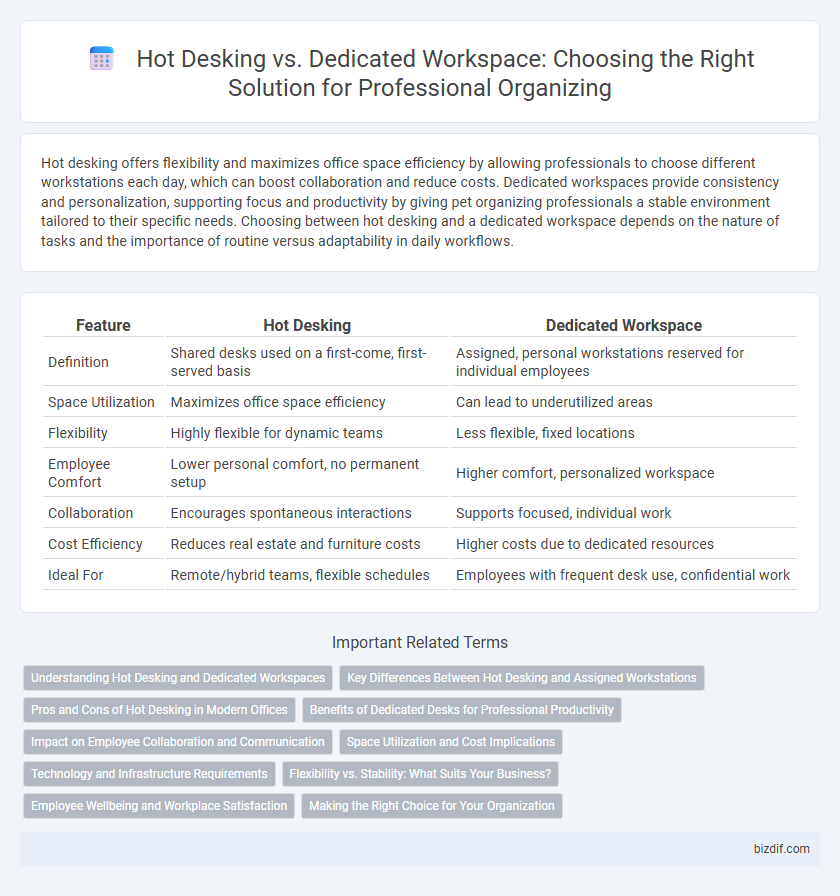Hot desking offers flexibility and maximizes office space efficiency by allowing professionals to choose different workstations each day, which can boost collaboration and reduce costs. Dedicated workspaces provide consistency and personalization, supporting focus and productivity by giving pet organizing professionals a stable environment tailored to their specific needs. Choosing between hot desking and a dedicated workspace depends on the nature of tasks and the importance of routine versus adaptability in daily workflows.
Table of Comparison
| Feature | Hot Desking | Dedicated Workspace |
|---|---|---|
| Definition | Shared desks used on a first-come, first-served basis | Assigned, personal workstations reserved for individual employees |
| Space Utilization | Maximizes office space efficiency | Can lead to underutilized areas |
| Flexibility | Highly flexible for dynamic teams | Less flexible, fixed locations |
| Employee Comfort | Lower personal comfort, no permanent setup | Higher comfort, personalized workspace |
| Collaboration | Encourages spontaneous interactions | Supports focused, individual work |
| Cost Efficiency | Reduces real estate and furniture costs | Higher costs due to dedicated resources |
| Ideal For | Remote/hybrid teams, flexible schedules | Employees with frequent desk use, confidential work |
Understanding Hot Desking and Dedicated Workspaces
Hot desking involves employees sharing unassigned desks, promoting flexibility and space efficiency, which suits dynamic office environments with frequent collaboration. Dedicated workspaces assign specific desks or offices to individuals, enhancing personal comfort, organization, and consistency, ideal for roles requiring privacy or extensive equipment. Understanding these models helps businesses optimize workspace utilization, employee productivity, and organizational structure.
Key Differences Between Hot Desking and Assigned Workstations
Hot desking involves employees sharing unassigned desks, promoting flexibility and space efficiency, while dedicated workstations are permanently assigned to individuals, supporting personalization and consistent access to resources. Hot desking reduces real estate costs and adapts to fluctuating workforce sizes, whereas assigned workstations boost employee stability and organization. The decision between the two depends on organizational culture, workflow needs, and the value placed on collaboration versus personal workspace customization.
Pros and Cons of Hot Desking in Modern Offices
Hot desking offers flexibility and optimizes office space by allowing employees to use any available desk, reducing real estate costs by up to 30%. It encourages collaboration and adaptability but can lead to decreased personal workspace personalization and potential hygiene concerns. Challenges include logistical issues with equipment sharing and occasional disruptions in workflow due to the lack of a consistent workstation.
Benefits of Dedicated Desks for Professional Productivity
Dedicated desks enhance professional productivity by providing consistent, personalized workspaces that reduce time spent organizing and locating materials. They support better ergonomic setups tailored to individual needs, minimizing physical strain and increasing focus. Consistency in workspace also fosters deeper concentration and efficient workflow, leading to improved task completion and overall performance.
Impact on Employee Collaboration and Communication
Hot desking encourages spontaneous interactions and fosters dynamic collaboration by allowing employees to mix and communicate across departments more easily. Dedicated workspaces provide stability and personalized environments that enhance focused communication and deeper team cohesion over time. Organizations must balance these approaches to optimize collaboration based on their unique culture and workflow needs.
Space Utilization and Cost Implications
Hot desking maximizes space utilization by allowing multiple employees to share a single workspace, reducing the need for dedicated desks and lowering real estate costs. Dedicated workspaces provide consistent personal organization but require more square footage and higher overhead expenses. Companies balancing efficiency and employee preference often analyze occupancy rates and cost per square foot to determine the optimal workspace strategy.
Technology and Infrastructure Requirements
Hot desking requires robust wireless connectivity, cloud-based storage solutions, and mobile device compatibility to enable seamless transitions between workstations. Dedicated workspaces benefit from personalized technology setups, including fixed network ports, ergonomic hardware, and customized software configurations tailored to individual user needs. Investing in scalable infrastructure like unified communication platforms and reliable IT support is critical to maximizing productivity in both environments.
Flexibility vs. Stability: What Suits Your Business?
Hot desking offers unparalleled flexibility, allowing employees to choose different workstations daily and maximizing office space efficiency. Dedicated workspaces provide stability, fostering personalized environments that enhance focus and productivity for employees requiring consistent setups. Businesses prioritizing adaptability benefit from hot desking, while those valuing routine and individual comfort thrive with dedicated workstations.
Employee Wellbeing and Workplace Satisfaction
Hot desking enhances employee wellbeing by promoting flexibility and social interaction, which can reduce stress and increase job satisfaction. Dedicated workspaces provide stability and personalization, fostering a strong sense of ownership and comfort that boosts productivity and mental health. Balancing both approaches allows organizations to support diverse work styles, improving overall workplace satisfaction.
Making the Right Choice for Your Organization
Choosing between hot desking and dedicated workspaces depends on your organization's size, culture, and workflow needs. Hot desking enhances flexibility and reduces real estate costs for dynamic teams, while dedicated workspaces foster consistency and personal organization for employees requiring stability. Aligning workspace strategy with operational goals maximizes productivity and employee satisfaction in professional organizing environments.
hot desking vs dedicated workspace Infographic

 bizdif.com
bizdif.com